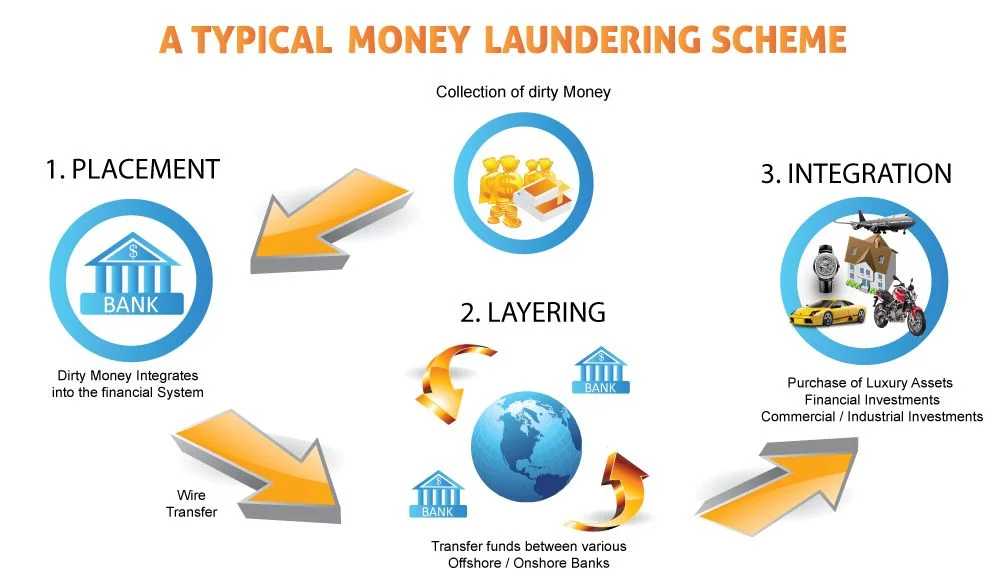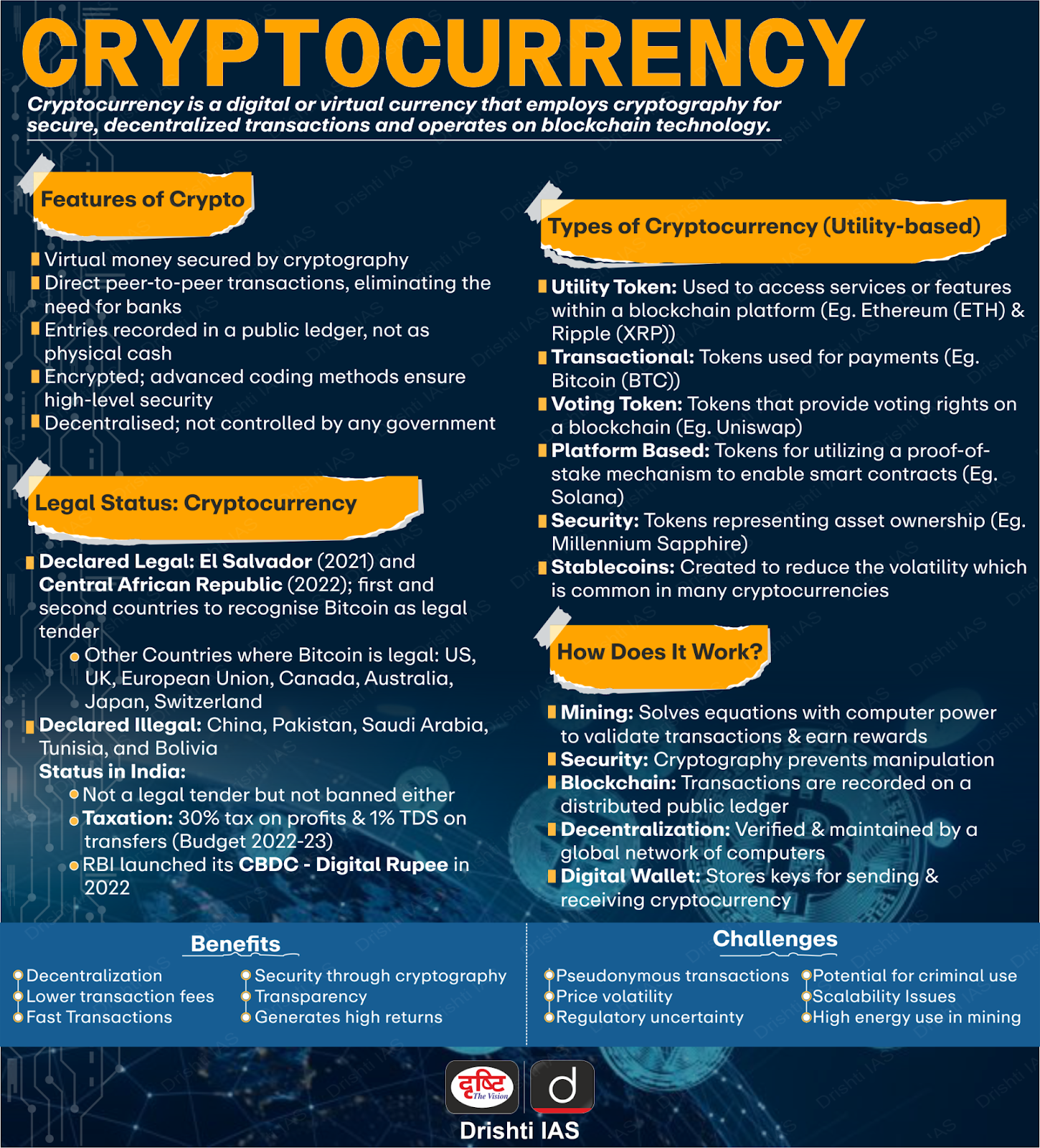Regulating Cryptocurrency in India | 18 Nov 2025
For Prelims: International Consortium of Investigative Journalists (ICIJ), Cryptocurrency, EU, RBI Ombudsman, SEBI, Enforcement Directorate (ED), I4C, CBI.
For Mains: About cryptocurrency and money laundering, Challenges, regulatory gaps, and policy measures for cryptocurrency governance in India, along with its use in cross-border money laundering and cybercrime.
Why in News?
A global investigation, titled The Coin Laundry, conducted by the International Consortium of Investigative Journalists (ICIJ), has uncovered how cryptocurrency exchanges have become a new hotspot for global money laundering.
How are Cryptocurrency Exchanges Being Used as Channels for Money Laundering?
- Placement: Cryptocurrencies are borderless, pseudonymous, and fast, offering limited traceability in the absence of strict KYC norms.
- Crypto "mixers" and "wallet hops" obscure ownership trails, making them ideal for laundering illicit proceeds.
- They may also use mule or pooled accounts to deposit cash and buy crypto like Bitcoin, taking advantage of the system’s pseudo-anonymity.
- Layering: In this stage, criminals hide the origin of funds by using multiple exchanges, privacy coins, KYC-free Decentralised Exchanges (DEXs), and chain-hopping ( moving cryptocurrency across multiple blockchains in quick succession).
- These tactics break the audit trail, making transactions very hard to trace.
- Actors involved include ransomware groups, drug syndicates, cyber fraud rings, and sanction evaders.
- Integration: In the final stage, the “cleaned” funds are converted back into fiat currency and moved into the legitimate economy.
- The criminal sells the obscured crypto on a laxly regulated foreign exchange and withdraws the fiat to a bank account, posing it as legitimate investment returns.
Money Laundering
- About: Money laundering is the illegal process of making dirty money — gained from criminal activity — look clean or legitimate.
- It disguises the true origin of the funds so they can be used without raising suspicion from law enforcement or financial authorities.
- Stages of Money Laundering:
What is Cryptocurrency?
- About: A cryptocurrency is a digital currency secured by cryptography and operates in a decentralized system without government control. Examples include Bitcoin, Ethereum, and Litecoin.
- Working of Cryptocurrency: Cryptocurrency transactions are recorded on a blockchain, a public digital ledger maintained by a global network of computers that verify and add each transaction.
- Users need a digital wallet that stores public and private keys used to send, receive, and verify transactions.
- Legal Status of Cryptocurrency in India: Cryptocurrency in India is unregulated but not banned.
- The government does not recognize it as legal tender and aims to restrict its use for illegal activities or as a payment method.
What are the Regulatory and Institutional Gaps in India’s Crypto Ecosystem?
Regulatory Gaps
- Lack of Clear Policy Framework: The government faces a paradox. Establishing clear crypto regulations may appear as endorsement and attract millions of new, risk-prone investors, while officials remain cautious about integrating a volatile, decentralized asset into the formal financial system due to potential systemic risks.
- Unclear Legal Definition: There is no legal clarity on whether crypto is a commodity, currency, asset, or new digital class, creating confusion over which regulator—RBI, SEBI, or a new body—should oversee it.
- Taxation and Compliance Issues: The 1% TDS on virtual digital assets, has led to an exodus of users, funds and trades to offshore platforms and complicating oversight, while unclear tax rules for staking, mining, and airdrops create confusion for users.
- Technological Oversight Gaps: Crypto evolves faster than policy, with tools like mixers, privacy coins, cross-chain bridges, and Decentralised exchanges (DEXs), making real-time enforcement extremely challenging.
Institutional Gaps
- Jurisdictional Enforcement Issues: Cryptocurrencies operate on a global, borderless network. Enforcing Indian laws on offshore exchanges that are accessible to Indian users is extremely difficult.
- In 21 months (Jan 2024–Sept 2025), Indian authorities flagged 27 crypto exchanges for laundering cybercrime proceeds, with about Rs 623 crore stolen from 2,872 victims routed to transnational syndicates.
- Operational Hurdles: The pseudo-anonymous nature of blockchain makes it hard for agencies like the Enforcement Directorate (ED) and I4C to trace funds, identify beneficiaries, and prove wrongdoing.
What Steps can India Take to Strengthen Cryptocurrency Governance?
- Clear Legal and Regulatory Frameworks: Cryptocurrencies should be legally classified as a distinct asset class (e.g., Crypto Assets or Digital Assets) to clarify laws and designate a lead regulator (e.g., SEBI for exchanges, RBI for stablecoins).
- A comprehensive Crypto Asset Regulation Bill should define regulator powers, illegal activities, and consumer protection measures.
- Robust Oversight of Intermediaries: All exchanges serving Indian users, domestic or offshore, should register with the regulator and follow strict Know Your Customer (KYC), Anti-Money Laundering (AML), and Combating the Financing of Terrorism (CFT) norms.
- They should also use advanced blockchain analytics to monitor transactions, flag suspicious activity, and report it to the Financial Intelligence Unit (FIU).
- Prioritize Consumer Protection: Launch awareness campaigns on crypto risks, mandate strict security protocols for exchanges and wallets—including proof of reserves and insurance, and establish a regulator-backed grievance redressal system for investors.
- Rationalize the Tax Regime: Reducing TDS could shift crypto activity back to Indian exchanges and improve transparency, while allowing investors to offset and carry forward losses would make the 30% tax on gains more equitable.
- Inter-Agency Coordination: Create specialized crypto units in agencies like ED, Income Tax, and CBI with blockchain forensic experts and collaborate with global regulators to track cross-border flows.
Conclusion
The Coin Laundry investigation highlights how cryptocurrency exchanges serve as conduits for money laundering, exploiting regulatory gaps globally and in India. The findings emphasize the urgent need for a comprehensive legal framework, robust KYC/AML oversight, investor protection, inter-agency coordination, and rational taxation to secure the digital asset ecosystem and curb illicit financial flows.
|
Drishti Mains Question What is cryptocurrency? Discuss the key challenges associated with regulating cryptocurrencies in India and suggest a way forward. |
Frequently Asked Questions (FAQs)
1. What is money laundering?
Money laundering is the illegal process of converting “dirty money” from criminal activities into seemingly legitimate funds through placement, layering, and integration stages..
2. What is cryptocurrency?
Cryptocurrency is a digital or virtual form of money that uses cryptography for security, operates on a decentralized network (usually a blockchain), and allows peer-to-peer transactions without the need for a central authority like a bank.
3. How are cryptocurrencies used in money laundering?
Crypto allows anonymous, cross-border transfers, often via wallets, mixers, and exchanges, making it difficult to trace funds and integrate illicit money into the legitimate financial system
UPSC Civil Services Examination, Previous Year Question (PYQ)
Prelims
Q. With reference to “Blockchain Technology”, consider the following statements: (2020)
- It is a public ledger that everyone can inspect, but which no single user controls.
- The structure and design of blockchain is such that all the data in it are about cryptocurrency only.
- Applications that depend on basic features of blockchain can be developed without anybody’s permission.
Which of the statements given above is/are correct?
(a) 1 only
(b) 1 and 2 only
(c) 2 only
(d) 1 and 3 only
Ans: (d)
Q. Consider the following pairs: (2018)
Terms sometimes seen in news Context/Topic
- Belle II experiment — Artificial Intelligence
- Blockchain technology —Digital/ Cryptocurrency
- CRISPR – Cas9 —Particle Physics
Which of the pairs given above is/are correctly matched?
(a) 1 and 3 only
(b) 2 only
(c) 2 and 3 only
(d) 1, 2 and 3
Ans: (b)
Mains
Q. Discuss how emerging technologies and globalisation contribute to money laundering. Elaborate measures to tackle the problem of money laundering both at national and international levels? (2020)
Q. What is Cryptocurrency? How does it affect global society? Has it been affecting Indian society also? (2019)




